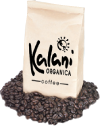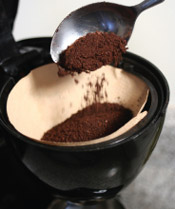Coffee rediscovered
This article was originally published in March 2012
All coffee at PCC is organic, fairly traded, shade-grown, and Northwest-roasted. We’re excited to share the great quality of our brew and we’d love you to try it — stop by our coffee bars for a small drip coffee for just 50 cents all month! If you make your own at home, try any of these six brands, in packages or bulk.

Tony’s Coffees has been small-batch roasting specialty coffees for more than 40 years and builds direct relationships with coffeegrowing families. The Bellingham-based company is a sponsor of PCC Farmland Trust.
Matt Bunn of Tony’s says: “When pairing coffees with foods, you may find a dark French roast nicely complements a sweet, chocolate croissant, and a crisp, citrusy single-origin coffee may pair well with a savory tomato focaccia.
“Our medium- and light-roast coffees, including Café Carmelita and the singleorigin Peruvian, are great choices to start the day with a bright, sweet cup of coffee.”

Café Ladro’s Jared Linzmeier travels each year to buy personally selected beans direct from the farmers. The Fremont blend is a lighter roast with flavors of pear, Rooibos and almond, and the Diablo is a dark roast made with beans with big, earthy flavors such as cloves, tobacco leaves and brown sugar. Café Ladro won the 2010 Seattle Magazine Readers’ Choice award.
Jared Linzmeier says: “Think of coffee like a great steak. Just as you may like steak medium-rare to really appreciate the flavor, a lighter roast can bring out the complexity of flavor in the coffee bean. Darker roasts are
better suited if you add cream or milk.”

Fidalgo Bay Coffee Roasters establishes direct relationships with growers and supports small coffee farms. The coffee it sells at PCC is roasted to order in small batches to ensure quality then delivered directly to PCC that day.
Fidalgo Bay’s Darryl Miller says: “Our Nature’s Crest Breakfast Blend is a great “wake-you-up” coffee that goes well with hearty, savory breakfast fare such as omelets, whereas our darker French roast is great with sweets. My favorite is our Nature’s Crest Café Centro blend, which comes out beautifully if you use a French press, pour-over
dripper or stove-top mokka pot.”

Equal Exchange is a worker-owned cooperative that imports coffee certified fair trade by the Institute for Marketecology, or IMO, which also certifies fair labor practices are used from the farm all the way up the supply chain. Equal Exchange sources directly from farmer cooperatives and often pays prices above what’s required by some fair trade certifiers. The company supports the preservation of sensitive areas and reforestation of degraded land in coffee-growing regions.
Equal Exchange’s Rick Doughty says: “Our Nica French roast has been the biggest seller in Seattle for the past six years. It’s dark and smoky with a sweet maple aroma and balanced flavors of dark chocolate and toasted almond.”

Kalani Coffee is handroasted in Seattle. Kalani’s hot, fast “West Coast”- style roast produces deep-flavored and fullbodied single-origin coffees and blends.
Kalani’s Karen Gorder says: “I love our Sumatra for its uniqueness and rich finish and the decaf for its smooth taste when I want coffee but little caffeine. Savory foods pair well with the Sumatra and Ethiopia, while sweet foods are great with the French roast.”

Ethical Bean Coffee buys fair trade beans seasonally from farmer cooperatives and experiments with various roast profiles and blends in its carbon-neutral roasting facility in Vancouver. The QR code on every bag of
Ethical Bean Coffee allows you to follow your coffee from crop to cup. Ethical Bean partners with Guatemalan organizations that provide scholarships for kids and supports a number of community efforts around Vancouver.
Ethical Bean’s Marianne Pemberton says: “Our Rocket Fuel (French roast) will kick-start your day when taken alongside your breakfast, while our medium-roast Classic will perk up your afternoon with elegance and
nuance. Whether the best roast profiles are achieved with single-origin coffees or blends, it’s all about finding the best magic between the green coffee bean and the roast.”
Coffee: Did you know?

What’s the best way to brew?
Brew methods that employ a paper filter (drip, aeropress, siphon) help bring out the complexities and nuances in a
coffee, which makes them great for lightroasted and single-origin coffees. If you’re brewing a medium- or dark-roasted coffee, a method that uses a metal filter (French press or stovetop mokka pot) will accentuate the heavier body and deeper flavor notes that make these roasts popular. For all methods, the proper grind and quantity are key for enjoying coffee at its best.
Why shade-grown?
All organic coffee must be shade-grown, meaning it’s grown under a canopy of diverse shade trees, often on small farms using traditional techniques. Shade-grown coffee fields provide food and shelter for songbirds, as well as habitat for other animals and plants.
Coffee and health
Research indicates coffee may lower the risk of heart disease and has beneficial antioxidants. It’s also a mild painkiller: drinking coffee before you exercise can enhance your workout and prevent post-workout muscle aches.
Coffee’s “acidity”
“Acidity” in coffee references two separate meanings: the way it tastes and the way it affects your body.
Acidity and taste: “Acidity in coffee refers to a certain ‘mouthfeel,’ and definition,” says Marianne Pemberton of Ethical Bean Coffee. It’s gives coffee its brightness and liveliness.
There are more than 1,000 different chemical compounds identified in coffee and about 50 are acids, many of which diminish in roasting. A (very) general rule is the lighter the roast, the higher the acidity; darker roasts have
lower acidity. Matt Bunn of Tony’s says “some of the coffee’s acids will increase due to roast level and some will diminish, but the levels of perceivable acids diminish.”
Some beans of a certain origin and grown at a lower elevation (such as Brazil, Sumatra and India) can have naturally lower acidities, but a high-acid green bean can be roasted dark and lose much of its initial acid.
Acidity and the body: If you don’t drink coffee because it irritates your stomach, you may just be drinking the wrong kind. Researchers have found that dark-roasted coffees are easier on the stomach than light because they contain a particular compound that prevents the stomach from producing too much acid.
Some compounds in coffee, including caffeine, cause the stomach to create more acid, but another compound (Nmethylpyridinium, or NMP) reportedly has the opposite effect. Research shows NMP is generated as the coffee beans are roasted, and the longer and darker the roast, the higher its levels. Dark-roasted coffee can contain as much as twice the NMP levels as light-roast coffees, though that can vary depending on the variety of the bean. That’s good news for those who like their coffee rich and dark.
